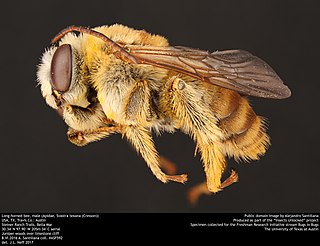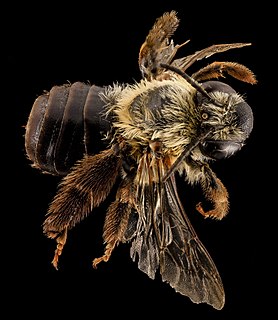
Melissodes rivalis is a species of long-horned bee in the family Apidae. It is found in North America.
Tetraloniella eriocarpi is a species of long-horned bee in the family Apidae. It is found in Central America and North America.
Tetraloniella is a genus of long-horned bees in the family Apidae. There are more than 100 described species in Tetraloniella.

Svastra texana is a species of long-horned bee in the family Apidae. It is found in Central America and North America.

Melissodes agilis, the agile long-horned bee, is a species of long-horned bee in the family Apidae. It is found in Central America and North America.
Syntrichalonia exquisita, the exquisite long-horned bee, is a species of long-horned bee in the family Apidae. It is found in Central America and North America.
Syntrichalonia is a genus of exquisite long-horned bees in the family Apidae. There are at least two described species in Syntrichalonia.

Martinapis is a genus of long-horned bees in the family Apidae. There are at least three described species in Martinapis.

Melissodes communis, the common long-horned bee, is a species of long-horned bee in the family Apidae. It is found in Central America and North America.

Svastra aegis is a species of long-horned bee in the family Apidae. It is found in North America.
Eucera edwardsii is a species of long-horned bee in the family Apidae. It is found in Central America and North America.

Melissodes dentiventris is a species of long-horned bee in the family Apidae. It is found in North America.
Tetraloniella pomonae is a species of long-horned bee in the family Apidae. It is found in Central America and North America.

Eucera rosae is a species of long-horned bee in the family Apidae. It is found in North America.
Melissodes robustior, the robust long-horned bee, is a species of long-horned bee in the family Apidae. It is found in North America.

Melissodes tepaneca, the tepanec long-horned bee, is a species of long-horned bee in the family Apidae. It is found in Central America and North America.
Martinapis occidentalis, the western morning long-horned bee, is a species of long-horned bee in the family Apidae. It is found in Central America and North America.
Melissodes paroselae, the parosela long-horned bee, is a species of long-horned bee in the family Apidae. It is found in Central America and North America.

Melissodes comptoides, the brown-winged long-horned bee, is a species of long-horned bee in the family Apidae. It is found in North America.

Svastra obliqua, the sunflower bee, is a species of long-horned bee in the family Apidae. It is found in Central America and North America.












